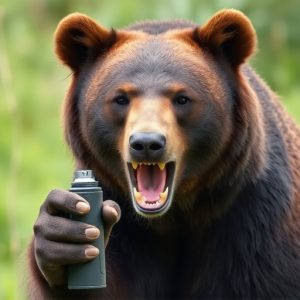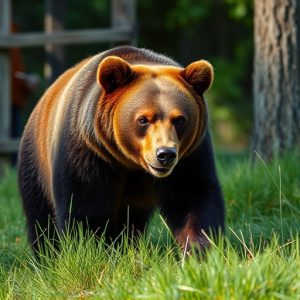Bear Spray Range: Understanding Protection, Avoiding Soil Contamination
Bear spray is an effective deterrence tool with a 30-foot barrier, temporarily disorienting bears an…….
Bear spray is an effective deterrence tool with a 30-foot barrier, temporarily disorienting bears and offering escape time. While its range and duration are key factors, soil contamination from aerosolized chemicals is a neglected issue, especially in ecologically sensitive areas like Alaska. Responsible usage involves proper application techniques, adherence to manufacturer instructions, and responsible disposal to balance personal safety with environmental preservation while ensuring the spray's longevity.
In Alaska, understanding bear repellent effectiveness is crucial for outdoor enthusiasts. This guide explores bear spray as a popular choice, delving into its maximum range, duration of protection, and soil contamination concerns. Learn how proper usage and disposal techniques maximize its potential. Discover the key factors influencing bear spray’s performance, including the surprising impact of soil contamination on its efficacy. By understanding these aspects, you’ll be better prepared for encounters in Alaska’s vast wilderness.
- Understanding Bear Spray: An Effective Repellent
- Soil Contamination: A Hidden Concern with Bear Spray
- Maximum Range: How Far Does It Really Work?
- Duration of Protection: What You Need to Know
- Responsible Use and Disposal for Optimal Effectiveness
Understanding Bear Spray: An Effective Repellent
Bear spray, also known as bear repellent, is a popular and effective tool for deterring bears in their natural habitat. It’s designed to create a barrier between you and the bear, often at a maximum range of 30 feet (9 meters), allowing individuals or groups to retreat safely. When used properly, bear spray can significantly reduce the risk of bear encounters turning aggressive.
The effectiveness of bear spray lies in its ability to emit a strong scent that bears find unpleasant, temporarily blinding them and giving you valuable time to escape. However, it’s crucial to remember that bear spray is not a permanent solution and should be used as a last resort during unexpected encounters. Proper usage involves aiming the spray towards the bear’s face while back-away, ensuring minimal soil contamination from the aerosolized chemicals. The duration of its effectiveness varies depending on factors like wind speed and weather conditions, making it essential to stay alert even after spraying.
Soil Contamination: A Hidden Concern with Bear Spray
The effectiveness of bear spray, also known as bear repellent, is often measured in terms of its range and duration. However, an often overlooked concern is soil contamination. When used improperly or in high concentrations, bear spray can have detrimental environmental impacts, particularly in sensitive ecosystems like Alaska’s. The chemicals present in these sprays can persist in the environment, potentially contaminating soil and water bodies for extended periods.
This issue becomes especially critical when considering the long-term effects on wildlife and plant life. Even after the immediate threat from bears has subsided, residual bear spray chemicals in the soil could harm other animals and plants that depend on this ecosystem. Thus, while bear spray is a valuable tool for personal safety in bear country, it’s crucial to use it responsibly, following manufacturer guidelines, and being mindful of its potential impact on the environment over time.
Maximum Range: How Far Does It Really Work?
The maximum range of a bear repellent, particularly bear spray, is often a topic of interest for outdoor enthusiasts and alaskans alike. While manufacturers typically provide guidelines, understanding the actual distance it’s effective can be misleading. The ‘maximum range’ isn’t about a hard boundary; instead, it refers to the optimal distance for the spray to reach and deter bears effectively. Several factors influence this, including wind conditions, terrain, and the specific attributes of the repellent itself.
Bear spray is designed to create a barrier of capsaicin-based chemicals that can temporarily blind and disorientate bears. In ideal conditions, when sprayed directly towards the bear’s face or eyes, it can be effective up to 40 feet (12 meters). However, factors like soil contamination from previous uses, wind patterns pushing the spray away, or uneven terrain can significantly reduce its reach. Moreover, the duration of protection is not just about range; it’s also about how long the repellent remains active on the bear’s fur and in the air, which varies based on environmental conditions.
Duration of Protection: What You Need to Know
The duration of protection offered by bear spray is a critical factor for anyone venturing into Alaska’s wilderness. When used correctly, bear spray can provide a significant safety margin against potential encounters with bears. Typically, a single can of bear spray offers protection for around 20-30 feet (6-10 meters), making it an effective deterrent at close range. However, it’s essential to remember that the effectiveness decreases significantly beyond this range due to soil contamination and evaporation.
Soil contamination is a major factor in bear spray’s reduced efficacy over time. As the spray settles on the ground or into vegetation, the active ingredients can become less concentrated, reducing its ability to deter bears. Additionally, factors like wind and weather conditions can impact the spray’s range and longevity. Thus, it’s crucial to stay within the recommended range and reapply if necessary during longer outings or in conditions where soil contamination is likely.
Responsible Use and Disposal for Optimal Effectiveness
Using bear spray responsibly and properly is key to ensuring its effectiveness. When deploying bear repellent, aim for the eyes and nose of the bear, as these are sensitive areas. Keep in mind that the maximum range varies, but consistent use within recommended guidelines will maximize protection. It’s important not to waste spray by spraying too broadly or at angles not targeted towards the bear.
Proper disposal is equally crucial to prevent soil contamination. Bear spray canisters should never be left behind or discarded in the wilderness. After each use, dispose of them responsibly according to local regulations. This helps maintain a safe environment for both wildlife and future outdoor enthusiasts, ensuring that bear spray remains a reliable tool for safe interactions with bears without causing ecological harm.
In conclusion, understanding the maximum range, duration, and responsible use of bear spray is crucial in ensuring its effectiveness as a repellent. While the typical range is around 30 feet, factors like weather conditions and terrain can affect performance. Proper disposal methods are also key to minimizing soil contamination, an often overlooked concern with bear spray. By knowing the duration of protection—typically lasting up to 6 hours—and using it responsibly, you can enhance your safety in bear country. Remember, responsible use includes following instructions, staying calm, and ensuring proper storage for optimal effectiveness during encounters with these majestic yet potentially dangerous creatures.


